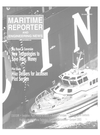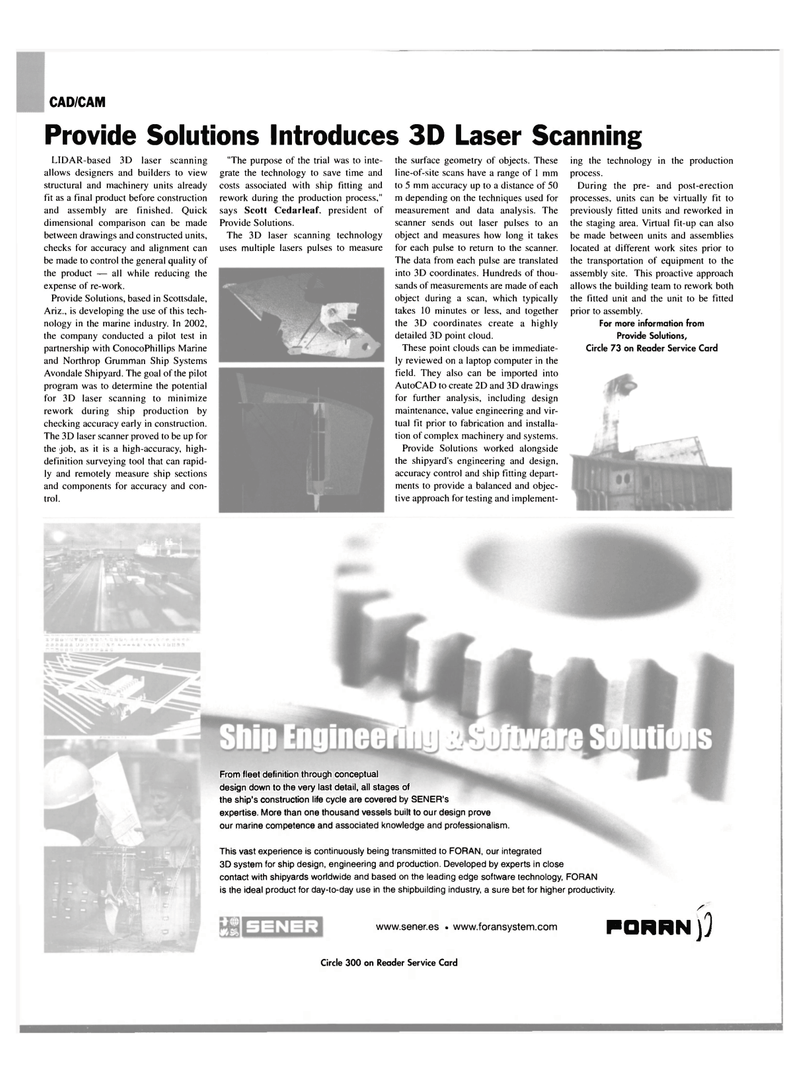
Page 58: of Maritime Reporter Magazine (October 2003)
Read this page in Pdf, Flash or Html5 edition of October 2003 Maritime Reporter Magazine
CAD/CAM
Provide Solutions Introduces 3D Laser Scanning
LIDAR-based 3D laser scanning allows designers and builders to view structural and machinery units already fit as a final product before construction and assembly are finished. Quick dimensional comparison can be made between drawings and constructed units, checks for accuracy and alignment can be made to control the general quality of the product — all while reducing the expense of re-work.
Provide Solutions, based in Scottsdale,
Ariz., is developing the use of this tech- nology in the marine industry. In 2002, the company conducted a pilot test in partnership with ConocoPhillips Marine and Northrop Grumman Ship Systems
Avondale Shipyard. The goal of the pilot program was to determine the potential for 3D laser scanning to minimize rework during ship production by checking accuracy early in construction.
The 3D laser scanner proved to be up for the job, as it is a high-accuracy, high- definition surveying tool that can rapid- ly and remotely measure ship sections and components for accuracy and con- trol. "The purpose of the trial was to inte- grate the technology to save time and costs associated with ship fitting and rework during the production process," says Scott Cedarleaf. president of
Provide Solutions.
The 3D laser scanning technology uses multiple lasers pulses to measure the surface geometry of objects. These line-of-site scans have a range of 1 mm to 5 mm accuracy up to a distance of 50 m depending on the techniques used for measurement and data analysis. The scanner sends out laser pulses to an object and measures how long it takes for each pulse to return to the scanner.
The data from each pulse are translated into 3D coordinates. Hundreds of thou- sands of measurements are made of each object during a scan, which typically takes 10 minutes or less, and together the 3D coordinates create a highly detailed 3D point cloud.
These point clouds can be immediate- ly reviewed on a laptop computer in the field. They also can be imported into
AutoCAD to create 2D and 3D drawings for further analysis, including design maintenance, value engineering and vir- tual fit prior to fabrication and installa- tion of complex machinery and systems.
Provide Solutions worked alongside the shipyard's engineering and design, accuracy control and ship fitting depart- ments to provide a balanced and objec- tive approach for testing and implement- ing the technology in the production process.
During the pre- and post-erection processes, units can be virtually fit to previously fitted units and reworked in the staging area. Virtual fit-up can also be made between units and assemblies located at different work sites prior to the transportation of equipment to the assembly site. This proactive approach allows the building team to rework both the fitted unit and the unit to be fitted prior to assembly.
For more information from
Provide Solutions,
Circle 73 on Reader Service Card www.sener.es • www.foransystem.com /r
FORRN))
This vast experience is continuously being transmitted to FORAN, our integrated 3D system for ship design, engineering and production. Developed by experts in close contact with shipyards worldwide and based on the leading edge software technology, FORAN is the ideal product for day-to-day use in the shipbuilding industry, a sure bet for higher productivity.
From fleet definition through conceptual design down to the very last detail, all stages of the ship's construction life cycle are covered by SENER's expertise. More than one thousand vessels built to our design prove our marine competence and associated knowledge and professionalism.
Circle 300 on Reader Service Card

 57
57

 59
59
